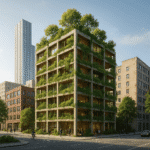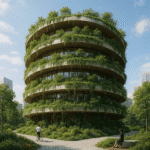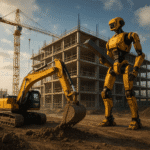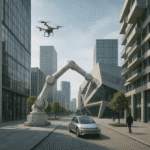Exploring the frontier of futuristic architecture reveals a vision of buildings that not only withstand the test of time but actively transform themselves to meet ever-changing demands. Designing for longevity requires a deep understanding of how structures can **evolve**, respond to environmental stressors, and maintain their **resilience** over decades or even centuries. Architects, engineers, and material scientists are collaborating to create living edifices powered by advanced **innovation**, merging aesthetic appeal with functional longevity. This article delves into emerging strategies that allow buildings to grow, adapt, and renew, forging a new era of sustainable design where form and function continuously coalesce.
Adaptive Structural Systems
At the heart of futuristic architecture lies the concept of structures that can shift their form and behavior in real time. Adaptive structural systems employ embedded sensors, actuators, and feedback loops to adjust to external forces, temperature fluctuations, and user needs. By integrating **cyber-physical** networks throughout a building’s frame, engineers enable dynamic load redistribution, preventing material fatigue and enhancing safety.
Sensors and Actuators
- Distributed fiber-optic sensors track strain and deformation.
- Shape-memory alloys act as micro-actuators, altering structural geometry.
- Smart joints with embedded motors can tighten or loosen connections.
Such systems can react to seismic activity by stiffening or decoupling elements, providing an unprecedented level of **adaptability**. Imagine a skyscraper whose core dynamically reinforces itself during high winds or an outreach canopy that extends to capture morning sunlight and retracts at dusk to conserve energy. These self-regulating capabilities extend a building’s lifespan, reducing the need for heavy maintenance and enabling graceful evolution across seasons and decades.
Sustainable Material Innovation
The pursuit of long-lasting architecture demands materials that can heal, regenerate, and adapt at the molecular level. Recent breakthroughs in **nanotechnology** and bio-inspired composites are revolutionizing the way we think about concrete, steel, and façade claddings. Self-healing concrete, for instance, embeds microcapsules filled with healing agents that release upon cracking, sealing fissures and halting deterioration.
Regenerative Composites
- Bio-based polymers mimic cellular regeneration found in living organisms.
- Photocatalytic coatings break down pollutants and regenerate surface quality under sunlight.
- Graphene-infused composites offer superior strength-to-weight ratios and electrical conductivity.
Architects harness these **regenerative** materials to design structures that age gracefully, transforming patinas into protective layers rather than signs of wear. Incorporating algae-based panels can produce oxygen and biomass, while phase-change materials manage thermal loads, reducing energy consumption. By prioritizing materials with embedded life cycles, buildings become living entities—able to repair, recycle, and reinvent themselves without major overhauls.
Modular and Reconfigurable Spaces
Flexibility is paramount when anticipating future changes in occupancy, function, and technology. Modular architecture envisions building components as interchangeable modules that can be reconfigured with minimal effort. This approach ensures that spaces can adapt to shifting demands, whether it’s converting office floors into residential units or expanding communal areas for cultural events.
Key Principles of Modularity
- Standardized connection points facilitate rapid assembly and disassembly.
- Plug-and-play electrical and mechanical interfaces allow seamless upgrades.
- Lightweight frame systems reduce foundation loads and simplify relocation.
Reconfigurable modules support circular economy principles: when a building’s purpose changes, modules can be relocated, refurbished, or repurposed elsewhere. This eliminates demolition waste and honors the ethos of **sustainability**. Users gain the freedom to personalize interiors, shifting walls, ceilings, and amenities like pieces in a living puzzle. Over time, a single building can serve diverse communities without ever facing obsolescence.
Integration of Digital Technologies
Digital transformation is reimagining how we design, build, and inhabit structures. From advanced Building Information Modeling (BIM) to artificial intelligence-driven maintenance, the digital layer is as crucial as concrete and steel. Real-time data streams inform predictive analytics, enabling facilities to anticipate failures before they occur and optimize resource allocation.
Smart Building Ecosystem
- Internet of Things (IoT) devices monitor occupancy, air quality, and energy use.
- AI algorithms recommend adaptive climate control, lighting, and security settings.
- Augmented reality interfaces guide on-site repairs and retrofits with precision.
These systems create a living feedback loop: sensor networks detect changes, AI interprets data, and management software orchestrates **autonomous** responses. A building can dim lights in unused corridors, reroute power during peak demand, or deploy drones for façade inspections, thereby minimizing human risk and maximizing efficiency. The fusion of digital intelligence with physical infrastructure propels longevity to new heights, as every aspect of a building becomes measurable, addressable, and improvable.










